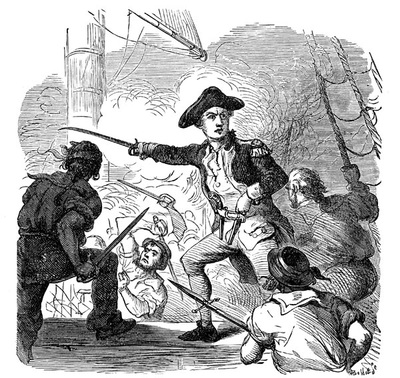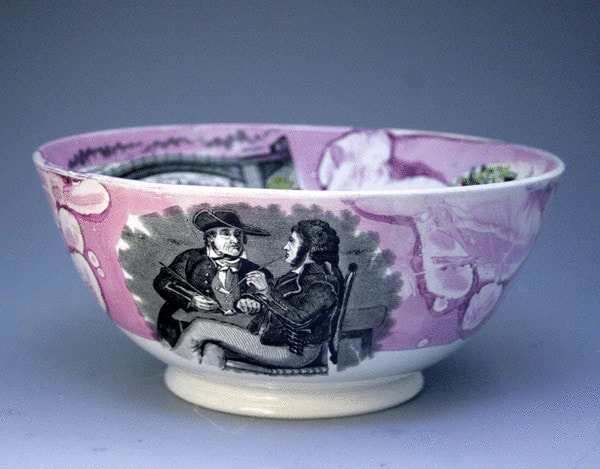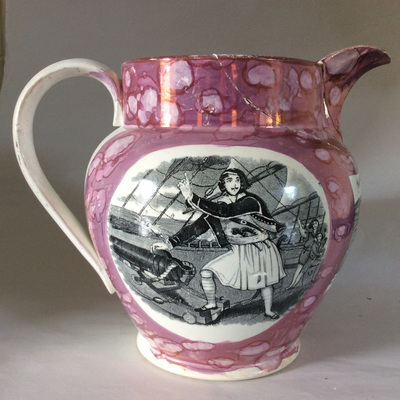|
10/17/2016 0 Comments Seaham Pottery 'Paul Jones' transferDepending on your perspective, John Paul Jones was either the father of the US Navy and hero of the American Revolutionary War (below right), or a pirate (below left). The transfer that appears on Seaham Pottery items is untitled, so it is hard to be 100% sure of its subject, and I haven't been able to identify the source. The Sunderland Museum display states that the figure is Byron. But I've also seen him listed (incorrectly) as Jack Crawford. Perhaps there was a commercial advantage in deliberately leaving his identity open. However, I'm still haunted by the centre image below from an old auction catalogue. (If you own the plaque, please get in touch!) Someone at the Seaham Pottery decided, for one day at least, that the image was to be titled 'Paul Jones'. The jug below, in the Sunderland Museum collection, is catalogued as 'probably Seaham Pottery', but I'm unsure on what basis. In fact, there are a whole group of distinctive transfers catalogued this way, which appear to be unique to the pottery. (More on that in the future.) The jug has a bridge transfer (left below) very similar to the one on the large Seaham jug in the museum (centre below), dated 1847, but they are different - from memory, the transfer on the large jug is smaller. The below right image is from an Albion Pottery (Tyneside) plaque, c1864. Again it is different - note the triangular sail on the front of the large ship in the foreground. The bowl below, from John Howard's archived items, has 'Paul Jones', accompanied by a very distinctive ship transfer, which to date I've only seen on the large Seaham jug in the museum collection (bottom centre and right). I'm unsure whether the two ships come from the same copper plate (without a high resolution image, it's difficult to tell). John's bowl has a bridge transfer that matches the one on the smaller jug above. Anyway, here's the exciting thing, for me at least. I've long known that the plaque on the left below was likely Seaham, but I couldn't reconcile that with the fact that identical plaques are found with religious verses – same unusual large size (215 x 238 mm), buttery lustre, and distinctive decoration. Those verse transfers (the very same ones) also appear on 1850s' plaques with the John Carr & Sons impress. So how did the copper transfer plates find their way from south of Sunderland, up to North Shields on the Tyne? I think the answer could be in the advert below. John Hedley Walker, the owner of the Seaham Pottery, moved his operations to Carr's Hill Pottery near Gateshead in 1849. Now, lest we get too excited, 'Carr's Hill' refers to a village, and not to the North Shields potter of the same name. However, this does provide a plausible explanation for why the copper plates might have migrated northwards beyond Sunderland to Tyneside. P.S. Thanks to Ian Sharp for getting in touch and pointing out the Byron connection to Seaham. Byron married Annabella Milbanke at Seaham Hall in 1815. So the pottery had more reason than most to celebrate the poet. Byron spent time in Greece and had himself painted in Greek dress (see right below). So it's possible the transfer depicts him. We may never know until we discover the source for the transfer.
0 Comments
Leave a Reply. |
AuthorStephen Smith lives in London, and is always happy to hear from other collectors. If you have an interesting collection of plaques, and are based in the UK, he will photograph them for you. Free advice given regarding selling and dispersal of a collection, or to those wishing to start one. Just get in touch... Archives
February 2022
AcknowledgementsThis website is indebted to collectors, dealers and enthusiasts who have shared their knowledge or photos. In particular: Ian Holmes, Stephen Duckworth, Dick Henrywood, Norman Lowe, Keith Lovell, Donald H Ryan, Harold Crowder, Jack and Joyce Cockerill, Myrna Schkolne, Elinor Penna, Ian Sharp, Shauna Gregg at the Sunderland Museum, Keith Bell, Martyn Edgell, and Liz Denton.
|




















